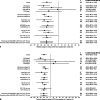Change in Urine Albumin-Creatinine Ratio and Occurrence of Hyperkalemia in Patients Initiating Finerenone in the USA: A Cohort Study from the FOUNTAIN Platform
- PMID: 40015260
- PMCID: PMC12215156
- DOI: 10.1159/000543923
Change in Urine Albumin-Creatinine Ratio and Occurrence of Hyperkalemia in Patients Initiating Finerenone in the USA: A Cohort Study from the FOUNTAIN Platform
Abstract
Introduction: In 2021, finerenone - a novel, selective nonsteroidal mineralocorticoid receptor antagonist - was approved in the USA to treat adults with chronic kidney disease (CKD) and type 2 diabetes (T2D). This study aimed to describe characteristics and short-term outcomes of patients prescribed finerenone since regulatory approval.
Methods: This was a retrospective cohort study using claims and electronic health records data from the OM1 Real-World Data Cloud™. A total of 15,948 US adults with a previous diagnosis of CKD and T2D who initiated 10 mg or 20 mg finerenone between July 2021 and August 2023 were included. Dosing was evaluated at baseline and over up to 12-month follow-up. Change from baseline in urine albumin-to-creatinine ratio (UACR) was evaluated at 4 and 12 months (among 913 and 443 patients, respectively, with available repeat UACR values). Hyperkalemia occurrence was determined at 12 months and over total follow-up.
Results: Median follow-up was 7.2 months. Mean age was 70.3 years, and 44.1% were female. At baseline (-365; 0 days), 70% had CKD stage 3; for patients with UACR measurements, 80.8% had moderate/severe albuminuria (≥30 mg/g). Median UACR was 203 mg/g. Co-medication use was ACE inhibitors/ARBs (51%), SGLT2is (38%), and GLP-1 RAs (26%). 86% of patients initiated 10 mg finerenone, and among 2,212 patients still under observation at 12 months, 70% were on 10 mg. For finerenone initiators with available UACR data, UACR was reduced by 33% at 4 months and 38% at 12 months. Hyperkalemia occurred in 1.2% of the cohort by 12 months (incidence 2.0 per 100 person-years).
Conclusion: Patients who initiated finerenone had a notable reduction in median UACR at 4 months, sustained at 12 months; hyperkalemia occurrence appeared to be low. These initial findings from US clinical practice should be complemented by results from other real-world cohorts of patients started on finerenone.
Keywords: Chronic kidney disease; Finerenone; Hyperkalemia; Urine albumin-creatinine ratio.
© 2025 The Author(s). Published by S. Karger AG, Basel.
Conflict of interest statement
Csaba P. Kovesdy declares consultancy work for Abbott, Akebia, AstraZeneca, Bayer, Boehringer Ingelheim, Cara Therapeutics, CSL Vifor, GlaxoSmithKline, ProKidney, Pharmacosmos, and Takeda. Natalie Ebert declares receiving honoraria from Bayer AG. Mikhail N. Kosiborod has received institutional research grants from AstraZeneca, Boehringer Ingelheim, and Pfizer; performed consultancy/advisory board work from 35Pharma, Alnylam, Amgen, Applied Therapeutics, Arrowhead Pharmaceuticals, AstraZeneca, Bayer, Boehringer Ingelheim, Corcept Therapeutics, Cytokinetics, Dexcom, Eli Lilly, Esperion Therapeutics, Imbria Pharmaceuticals, Janssen, Lexicon Pharmaceuticals, Merck (Diabetes and Cardiovascular), Novo Nordisk, Pfizer, Pharmacosmos, Regeneron, Sanofi, scPharmaceuticals, Structure Therapeutics, Vifor Pharma, and Youngene Therapeutics; received other research support (data analytic center fees – payments to institution) from AstraZeneca and Vifor Pharma; received institutional honoraria from AstraZeneca, Boehringer Ingelheim, and Novo Nordisk; and holds personal stock options with Artera Health and Saghmos Therapeutics. J. Bradley Layton, Ryan Ziemiecki, Catherine B. Johannes, and Manel Pladevall-Vila are employees of RTI Health Solutions, which received research funding from Bayer AG. Bishnu Bahadur Thapa, Mudit Bhartia, and Luis Rangel are employees of OM1 Inc., which received research funding from Bayer AG. Gary Curhan is an employee of OM1 Inc., which received research funding from Bayer AG, and has also been a consultant for Atom Bioscience; received grant support from GSK and is a Section Editor and Author for UpToDate. Michael Walsh, Patrick O. Gee, Nichole Jefferson, Annie Chicoye, and Maria Lopes have no conflicts of interest. Fangfang Liu, Alfredo E. Farjat, and Nikolaus G. Oberprieler are employees of Bayer. David Vizcaya was an employee of Bayer at the time the study was carried out and is currently an employee of Alexion Pharmaceuticals S.L., Barcelona, Spain.
Figures


References
-
- Kidney Disease Improving Global Outcomes KDIGO Diabetes Work Group . KDIGO 2022 clinical practice guideline for diabetes management in chronic kidney disease. Kidney Int. 2022;102(5S):S1–27. - PubMed
-
- Jadoul M, Aoun M, Masimango Imani M. The major global burden of chronic kidney disease. Lancet Glob Health. 2024;12(3):e342–3. - PubMed
-
- Thomas MC, Cooper ME, Zimmet P. Changing epidemiology of type 2 diabetes mellitus and associated chronic kidney disease. Nat Rev Nephrol. 2016;12(2):73–81. - PubMed
-
- Ohta M, Babazono T, Uchigata Y, Iwamoto Y. Comparison of the prevalence of chronic kidney disease in Japanese patients with Type 1 and Type 2 diabetes. Diabet Med. 2010;27(9):1017–23. - PubMed
Publication types
MeSH terms
Substances
LinkOut - more resources
Full Text Sources
Medical
Miscellaneous

